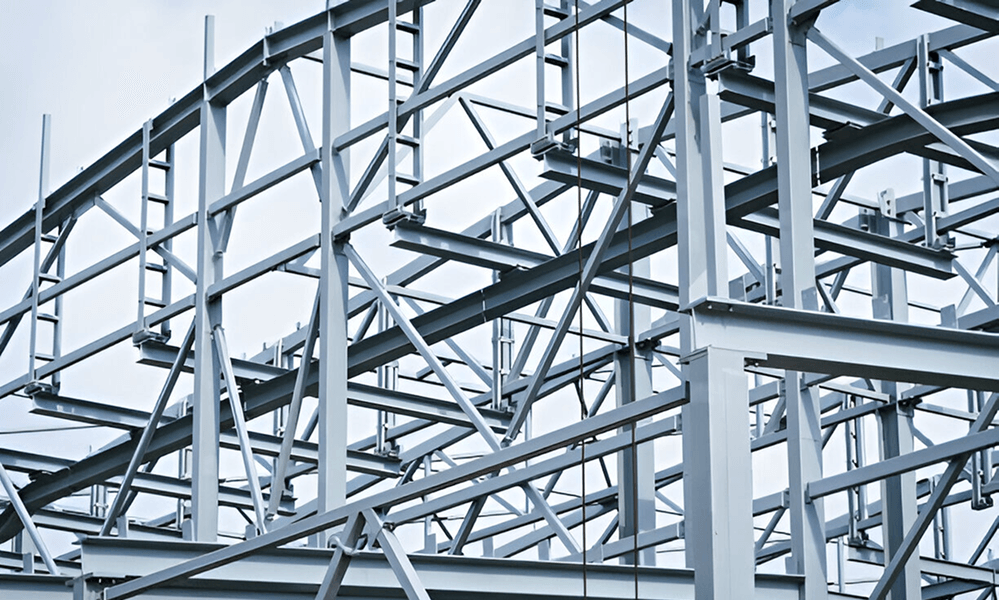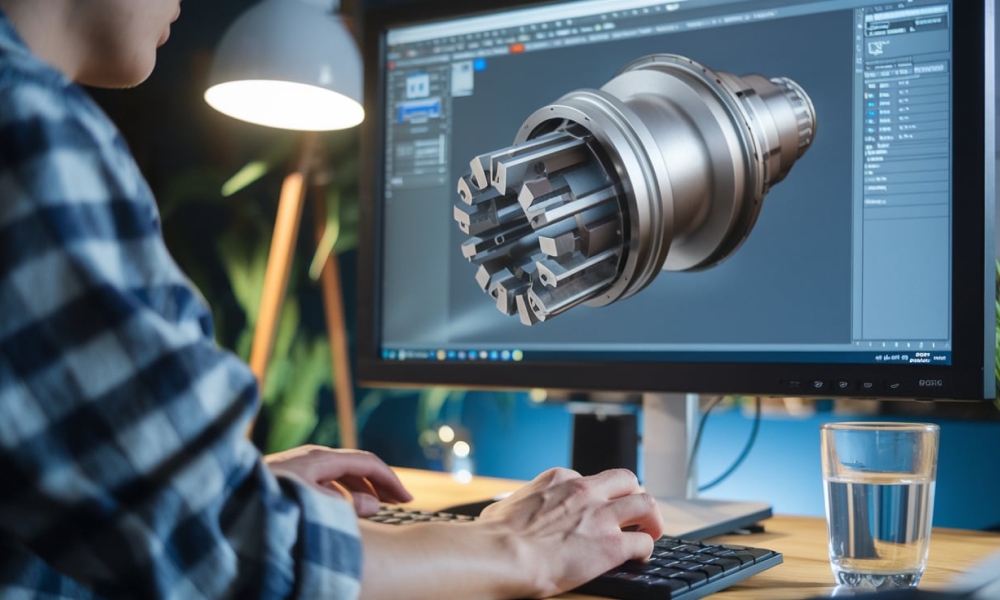Structural steel is the backbone of modern construction and industrial infrastructure. From cranes to bridges and industrial plants, steel provides the strength, flexibility, and durability necessary for these structures to withstand the test of time.
According to the World Steel Association, over 1.84 billion tons of crude steel were produced globally in 2024, making it one of the most widely used materials.
Despite its popularity, designing steel structures isn’t easy. A single design flaw can lead to excessive costs, safety hazards, and structural failures. That’s why careful planning and a solid understanding of fundamental engineering principles are crucial.
Whether you’re an engineer, manufacturer, or project stakeholder, knowing these principles is key to creating strong, efficient, and long-lasting structures.
Read the blog to explore the essential principles of structural steel design. Apply these insights to make smarter decisions, cut costs, and build more reliable steel structures.
1. Load Considerations
Steel structures are meant to withstand various loads that change over time. To ensure long-term durability, they must be designed to resist these forces without failure.
The main types of loads include:
- Dead Load: The weight of the structure itself, including beams, columns, and permanent fixtures.
- Live Load: Variable loads like people, equipment, or movable furniture.
- Wind Load: The lateral force exerted by wind (crucial for high-rise buildings and open-frame structures).
- Seismic Load: Forces due to earthquakes, requiring special design measures in seismic zones.
- Snow and Rain Loads: Additional weight from weather conditions, especially in colder climates.
- Impact and Dynamic Loads: Loads from machinery, moving vehicles, or other forces that create sudden impacts.
To ensure your steel structure can withstand these loads, it’s important to analyze their combined effects through load combinations as per ASCE 7 standards. A clear load path prevents weak spots and failures.
2. Structural Stability
Beyond handling external loads, a steel structure must stay stable over time without collapsing. Structural stability ensures loads are evenly distributed, preventing localized stress points and unexpected failures.
Key design factors include:
- Bracing Systems: Incorporate diagonal, shear, or moment frames to keep the structure from shifting sideways. Wind bracing and K-braces can be added help transfer forces efficiently.
- Buckling Resistance: Slender columns and beams can fail under pressure. Use Euler’s buckling theory and K-values to ensure they stay strong.
- Deflection Limits: Too much bending can weaken a structure. Follow AISC 360 guidelines to keep movements within safe limits.
One key element in determining stability is the stability coefficient (or, buckling coefficient). It measures how well a structure resists buckling — the higher the value, the more stable it is.
Factors like slenderness ratio, material properties, load distribution, and cross-section shape all affect the coefficient, which in turn impacts overall stability of the steel structure.
3. Material Selection
Not all steel is same. And picking the right one is key to a strong and reliable structure. Consider factors like strength, ductility, corrosion resistance, and cost before making a choice.
Here are some commonly used steel grades:
- A36 Steel: A versatile, cost-effective option for general structures.
- High-Strength Low-Alloy (HSLA) Steel: Offers better strength-to-weight ratio and corrosion resistance.
- Weathering Steel (Corten Steel): Resistant to atmospheric corrosion, reducing maintenance needs.
- Stainless Steel: Ideal for corrosive environments like chemical plants and coastal areas.
In structural applications, yield strength (𝐹𝑦) and ultimate tensile strength (𝐹𝑢) are critical parameters defined by ASTM A992 (for wide-flange beams) and ASTM A572 (for HSLA steel). Selecting the right material can help you minimize long-term maintenance and ensure compliance with industry requirements.
4. Industrial Standards and Codes
Different countries have their own standards for structural steel based on local climate, geology, and safety requirements. These standards guide material selection, design, and manufacturing methods.
For example, the U.S. follows AISC (American Institute of Steel Construction) standards. European countries adhere to BS (British Standards) and Eurocodes. Australia follows AS (Australian Standards). Sticking to the right standards ensures structural safety and local compliance.
Some of the most recognized standards include:
- American Society for Testing and Materials (ASTM) Standards: Defines steel material properties.
- International Building Code (IBC): Incorporates steel design criteria for safety regulations.
- OSHA Standards: Covers workplace safety in steel fabrication and erection.
- AISC 360 (Specification for Structural Steel Buildings): The primary standard for steel structure design in the U.S.
- AISC 341 (Seismic Provisions for Structural Steel Buildings): Guidelines for designing steel structures to withstand seismic forces.
- AWS D1.1 (Structural Welding Code): The American Welding Society’s standard for welding structural steel, widely used in fabrication and construction.
- Eurocode 3 (EN 1993-1-1): The European standard for design of steel structure, covering strength, stability, and durability.
- AS 4100 (Steel Structures Code): Australia's key standard for steel structure design and fabrication.
- AS/NZS 5131: Australian/New Zealand standard for the fabrication and erection of structural steelwork.
One must consider both local and international standards when designing steel structures to avoid costly rework, compliance issues, and safety risks. Ignoring them can lead to project delays, structural failures, or last-minute modifications to meet approval.
5. Connections
Connections are essential for holding a steel structure together, transferring forces between members to keep everything stable. When picking the right type, you need to balance strength, ease of installation, and cost.
Some common types of steel connections include:
- Bolted Connections: Easy to install and modify, making them a go-to choice for field assembly.
- Welded Connections: Strong and rigid but require skilled labor and precise execution.
- Riveted Connections: Once widely used, now mostly replaced by bolting and welding, though still found in heritage structures.
- Pinned vs. Fixed Connections: Pinned connections allow movement, while fixed connections hold everything rigid.
Regardless of the connection type, the node design must reinforce the structure’s integrity and ensure proper transfer of shear, moment, and axial forces.
Using CAD modeling, we can create precise connection designs, improving accuracy and efficiency. Prequalified connections, like those in AISC 358, further simplify fabrication and assembly while keeping everything stable.
6. Fabrication and Erection Considerations
A well-designed steel structure should be practical to manufacture and assemble. Following considerations must be taken into account:
- Prefabrication Efficiency: Use standardized sections to minimize custom fabrication costs.
- Tolerances and Fit-up: Ensure precision in manufacturing to avoid assembly issues on-site.
- Transport and Handling: Design components for easy shipping and lifting at the job site.
Fabricators depend on detailed shop drawings from Tekla Structures or AutoCAD to get weld symbols, bolt placements, and plate sizes just right. At Sedin Engineering, we provide precise and code-compliant steel detailing service to streamline fabrication and minimize errors on-site.
7. Foundation and Anchorage
A steel structure is only as strong as its foundation. The foundation must:
- Support All Loads: Bearing the weight of the structure and distributing it safely to the ground.
- Prevent Settlement: Avoiding uneven settling that can cause instability.
- Resist Uplift and Lateral Movement: Especially important in wind and seismic conditions.
Before designing a steel framework, a geotechnical investigation is crucial to determine the right foundation system, whether it's drilled piers, mat foundations, or deep piles.
8. Aesthetics in Steel Structure Design
While functionality is critical, aesthetics also play a major role in steel structures, especially in architectural and public projects. Here's what to keep in mind:
- Exposed Structural Elements: Using steel’s sleek and modern look as a design feature.
- Curved and Custom Shapes: Advanced fabrication techniques allow for unique designs.
- Coatings and Finishes: Galvanizing, painting, or applying weathering steel for both protection and visual appeal.
- Integration with Other Materials: Blending steel with glass, concrete, or wood for a dynamic visual effect.
Aesthetic considerations make sure a structure isn’t just strong but also visually appealing. This allows the structure to blend smoothly into urban and industrial settings.
9. Sustainability
Sustainability is a growing priority in modern engineering. Structural steel supports green initiatives by being:
- 100% Recyclable: One of the most recycled materials globally.
- Efficient in Material Use: Advanced analysis reduces overdesign and waste.
- Energy-Efficient: Prefabrication reduces construction site emissions.
With net zero steel, structures can be built with low-emission or even emissions-free materials. This means a smaller carbon footprint without compromising strength.
By integrating sustainable materials into the design process, you can create structures that are not only strong and efficient but also meet green building standards like LEED. Smart steel design leads to a smarter and more sustainable future.
Related Blog: Introduction to Design for Manufacturing (DFM)
Looking for Structural Steel Design Services?
Steel structure design is both an art and a science, balancing strength, economy, and functionality. By mastering these key steel design principles — load considerations, stability, material selection, standards, connections, fabrication, foundation, and sustainability, we can create safe, efficient, and cost-effective structures.
Need strong, compliant, and cost-effective structural steel designs? Sedin Engineering has you covered. Let’s build smarter, stronger, and more sustainable structures. Contact us today!



